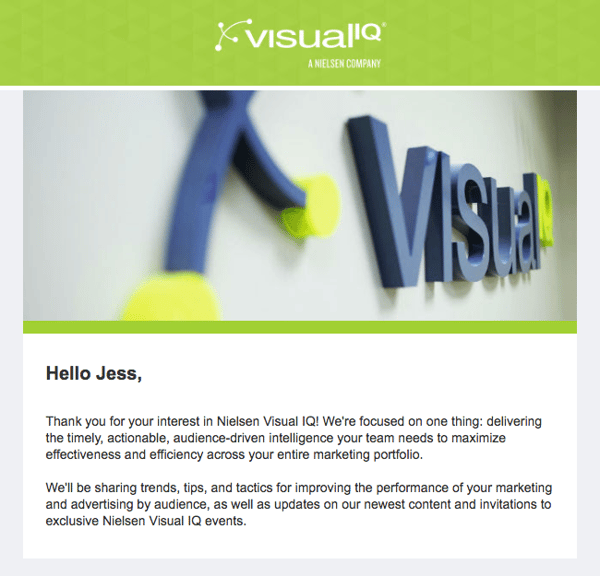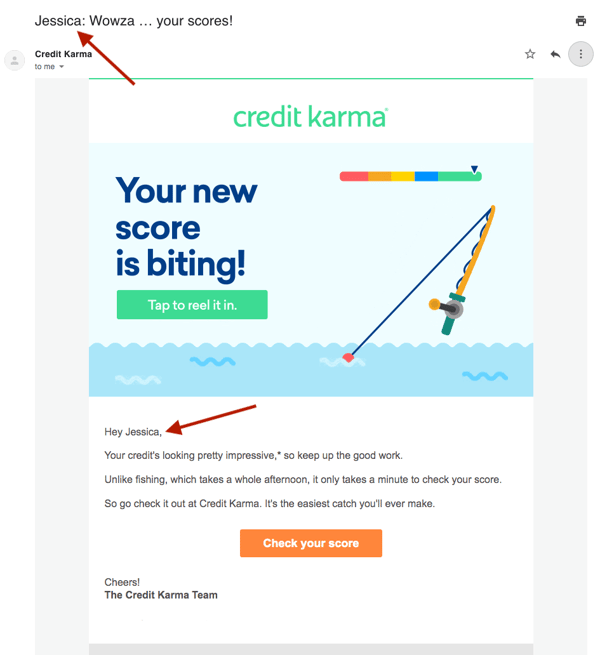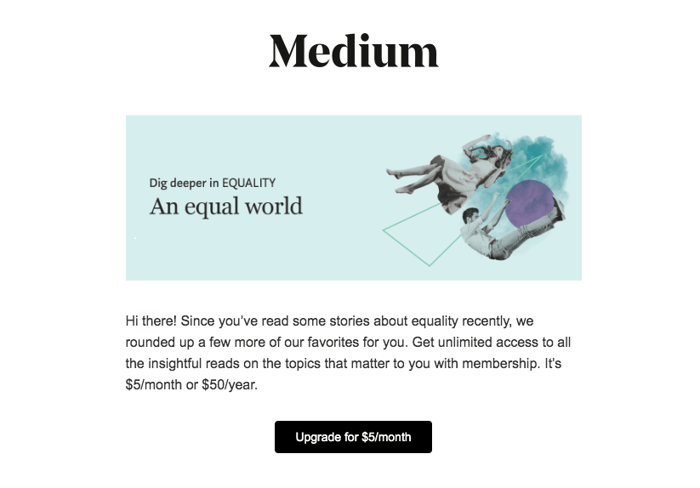Customers are important. After all, their business lets you stay in business.
Brands who don’t strive to create great experiences for their customers don’t just see their numbers stagnate. They soon find it difficult to gain trust and loyalty.
Brand experience and brand success have become inextricable. In an oversaturated market where there are dozens of solutions for every problem, the brands that make it a point to connect with consumers on a personal level will always come out on top.
So...what does that have to do with email?
Email is one of the oldest digital touchpoints out there, and yet it’s still hotly debated. Is it dead or not? Do people still rely on it, or do they hate it? Is it worth the investment, or is it really just glorified spam?
Here’s the thing. In a world dominated by mass media, email remains one of the few channels that actually still feels personal. And when it comes to creating a meaningful brand experience, that personal connection is invaluable.
Consumers don’t just want stuff—they want connection. They like to feel heard. They like being catered to, and they love added value. When a brand makes the effort to give them those things, they are much more likely to remain a loyal customer.
What better way, then, to personalize the experience and communicate with them directly than with email?
* * *
Why Email is Still Relevant
In recent years, myriad new ways to engage consumers have emerged. Businesses large and small can leverage the ubiquity of mobile technology to connect with their customers just about anywhere.
But even with the rise of social media, text messaging, apps, and (of course) digital ads, email remains both useful and relevant.
Personal opinions may vary on this, but the numbers don’t lie.
According to HubSpot, 59% of survey respondents said marketing emails have influenced their purchasing decisions, with 59% of marketers saying it's their biggest source of ROI.
With email, you have a direct, private line of communication with each customer, lead, and prospect. It’s also highly trackable and action-oriented, giving you lots of data that, in turn, can guide more informed marketing decisions.
In short, while some marketers may doubt it, not many have found an alternative to email that can replicate its directness, trackability, and data-oriented value.
So now that you understand why email is still important, let’s go over some email strategies, best practices, and techniques that will enhance your brand experience.
In particular, we will focus on:
- Establishing expectations
- Personalizing your emails
- Providing clarity and value
Let’s dive in.
* * *
Good Emails Set (and Adhere to) Expectations
There’s nothing worse than sharing your email address with a company and getting bombarded with a bunch of random, totally useless emails. From a customer’s perspective, there’s a word for unsolicited, excessive inbox-cloggers.
Part of establishing a meaningful line of communication with a customer, lead, or prospect is establishing expectations. In other words, you need to let them know what kinds of emails they will receive from your business and what value they will get.
Are you sending only marketing emails, or will you also send useful product updates and educational content?
What about frequency? Should they expect daily, weekly, or just occasional emails?
You can help establish expectations in a couple of ways. The first—and probably best—would be to include the information with your lead forms. This lets people know what they’re getting themselves into before any email is sent or received.
Here’s a great example from Pottery Barn:

In addition to the instant value offered in the form of a discount, they let you know exactly what they’ll be sending you (i.e. more offers). For deal-savvy consumers, this is a double whammy of value.
Additionally, you should include this information in a welcome email that’s triggered as soon as a person hands over their contact information. Not only will this serve to set expectations, but it also provides a sense of instant gratification.

It’s no secret that this is an automated email. No one thinks your customer service team is sitting around, anxiously awaiting someone to subscribe so they can shoot them an email.
Still, the acknowledgement and direct interaction is still there, and it further solidifies your brand (and your responsiveness) in the user’s mind.
Non-marketing emails are a different animal, of course, particularly support emails where you’re responding directly to requests from customers. While these emails require a slightly different kind of thinking, they contribute greatly to brand experience as well.
In this case, arguably the most important expectation to set is turnaround time, which is the length of time one could end up waiting for a response.
 Setting expectations upfront improves the overall experience by giving the consumer control. Whether or not they ultimately decide to engage, providing a choice and ditching the mystery will reflect positively on your brand.
Setting expectations upfront improves the overall experience by giving the consumer control. Whether or not they ultimately decide to engage, providing a choice and ditching the mystery will reflect positively on your brand.
* * *
People Love Personalization
Put your customer hat on for a moment. Imagine you’ve just received an email.
The email is about as canned as they come, most apparent in the sections that refer to you as “Valued Customer” when you haven’t even made a purchase. Or worse, maybe it includes one of the biggest spam giveaways, referring to you as “sir or madame.”
WTF?, you may think to yourself. Couldn’t they have put in just a LITTLE bit of effort?
It’s 2019, folks. Blatant copy-and-paste jobs are very off-putting. Consumers want to feel special and important, and when they don’t, they have no problem letting everyone know.
Personalization isn’t just a nice gesture. It’s something that consumers expect now.
In this case, a little email personalization goes a long way.
This a simple tactic, but it helps when creating a better email experience. Again, no one thinks you’re actually typing a personal email to them every single time, but the sense that there was some actual human thought behind it is still effective.
It doesn’t even need to be that complicated. Sometimes, it’s just as simple as using a person’s name in the subject line or salutation—or both!

If your website analytics and marketing automation systems are linked, you can even send personalized emails based off of users’ interactions with your content.

The worst case scenario is that you have to fall back on generics when people don’t provide information beyond their email address.
But the best case scenario is that a bit of personalization makes an impression, turning what might’ve been a boring ol’ email into a unique moment.
* * *
Email Can Provide Clarity and Value
Everyone’s time is valuable. In fact, there aren’t many things more frustrating than feeling like your time isn’t valued or is actively being wasted.
This is super important to remember as you plan your marketing emails.
Each email that is sent to your subscribers—whether it’s a batch email to the entire list or a one-off transactional email—needs to be clear and valuable. Nothing can sour a brand experience like feeling both confused and let down.
In other words, people receiving your emails should be able to point to information that answers a question, addresses a concern, offers access to a product or service, or otherwise provides results-oriented value.
Value and clarity are particularly important when sending promotional emails. Anyone with an email address knows how much junk can pile up in an inbox over the course of a day, so if you’re going to add to that pile, you better make it worth it.
The first hurdle is to get people to open the email to begin with. Your subject line needs to be enticing, but not spammy. More importantly, it needs to make clear what the email is about.
Again, setting expectations is crucial!
When a person opens the email, it needs to deliver on that expectation. The most important and relevant information should obviously sit at the top, but beyond that, it should be clear what actions you expect the reader to take next.
Want them to learn more about your product? Provide a clear link to a product page.
Want them to register for a webinar? Explain exactly what it will be about and link straight to the registration page.
Offering a coupon or limited-time sale? Provide a big, bold promo code for online purchases or a scannable barcode for in-store purchases.
Look at this example. A straightforward AND personalized subject line! A bright, eye-catching design! Body copy that matches the subject! A clear call to action! Be still our email-loving hearts.
This type of seamlessness adds to your overall brand experience. Think about it: The more obstacles and confusion a person encounters while interacting with your brand, the more frustrated they will become.
If things get too difficult, it will be very easy for them to move on.
In many ways, design plays a huge role here, too. Not only does it also contribute to the experience insofar as reinforcing your brand in general—because, ahem, your email design should be consistent with your branding—but it can reinforce the value you’re providing with clear visual cues and legibility.
Plus, when it comes to email marketing, a bit of eye candy never hurt anyone.
* * *
Putting It All Together
Although many new digital channels have emerged over the years, email is still as effective as ever when it comes to growing revenue and promoting your brand. Few channels provide such a personalized way to communicate with consumers.
Despite all of the discourse about it in the marketing world, the fact is that people continue to respond well to well-executed, well-designed emails. The numbers show that many are regularly swayed toward making purchases by email, making it a valuable asset in your marketing toolbox.
Most importantly, email provides an efficient way to deliver memorable experiences for your consumers, delivering timely information when they need it and providing value in ways that will foster trust and loyalty.
.png?width=250&height=153&name=CSI-OverskiesRebrand_LOGO-01(smaller).png)

.png?width=100&height=61&name=CSI-OverskiesRebrand_LOGO-01(smaller).png)





.png?width=88&name=CSI-OverskiesRebrand_LOGO-01(smaller).png)



